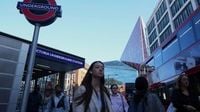Londoners found themselves grappling with unprecedented travel chaos this week as the capital’s famed Underground network ground to a near halt, the result of a major strike by thousands of Rail, Maritime and Transport (RMT) union members. The industrial action, which began on Sunday, September 7, 2025, and is set to continue through Friday, September 12, has left millions of commuters and travelers stranded, forced to scramble for alternative routes amid mounting frustration and economic fallout.
Negotiations between the RMT and Transport for London (TfL) collapsed on September 3, with union leaders warning that industrial relations had “totally collapsed.” Eddie Dempsey, general secretary of the RMT, didn’t mince words: “Our members are doing a fantastic job to keep our capital moving, and work strenuous shift patterns to make sure Londoners get to their destinations around the clock. Fatigue and extreme shift rotations are serious issues impacting on our members health and wellbeing – all of which have not been adequately addressed for years by London Underground management.” According to Dempsey, the union’s demands for a shorter working week and improved fatigue management have been consistently dismissed.
The heart of the dispute lies in the RMT’s call for a four-day, 32-hour working week, citing concerns over exhaustion and unsociable shift patterns. TfL, for its part, has offered a 3.4% pay increase but insists the union’s demands are “neither practical nor affordable.” Claire Mann, TfL’s chief operating officer, stated, “We call on the RMT to suspend this action, put our fair and affordable offer to their members and continue discussions with us. Our pay deal is in line with other offers accepted by the RMT across the rail industry, so it is disappointing the RMT is planning to disrupt Londoners without giving their members a say on the offer.”
With talks at a standstill and no further meetings planned, the strike’s impact has been swift and severe. On Tuesday, September 9, all Tube services except the Northern line—operating a reduced timetable—were suspended. The Docklands Light Railway (DLR), a crucial link for east London and London City Airport, also shut down as part of a separate dispute. The ripple effects were immediate: Oyster and contactless use across the TfL network dropped 23% compared to the same day last year, while alternative modes of transport saw dramatic surges. Bus boardings rose by 9%, London Overground journeys increased by 15%, and Elizabeth line usage soared by a third. Even cycle hire demand spiked, with 22,805 hires recorded by 3 pm—up 73% from the previous week, according to TfL figures cited by BBC News.
But as Londoners sought ways around the disruption, congestion and delays became the norm. Buses, trams, the Overground, and the Elizabeth line were left severely overloaded, with queues snaking around stations and many travelers expressing exasperation. One commuter told the BBC outside Poplar DLR station, “I have a kid who was affected. I couldn’t get her to school on time. I had to work. I got on three buses but I still couldn’t make it to work on time.” Another remarked that a commute normally taking eight minutes had ballooned into a 50-minute walk—though, with a touch of British stoicism, he added, “The weather is good, so no complaints.”
Tech infrastructure buckled under the pressure as well. On September 8, TfL’s website and app crashed as commuters desperately searched for route alternatives. Ride-sharing services like Uber warned of soaring fares as demand spiked. For those needing to reach London’s airports and international rail stations, the usual convenience of the Tube was gone. The Elizabeth line became the main artery to Heathrow, while Thameslink and other rail services were recommended for Gatwick, Luton, and Stansted airports. However, even these services faced delays and overcrowding, with the Elizabeth line experiencing points failures and Thameslink unable to serve key stations at certain hours.
The chaos extended far beyond the daily commute. Major events were forced to adapt or cancel. Coldplay, scheduled to play two sold-out concerts at Wembley Stadium, announced, “Without a Tube service, it’s impossible to get 82,000 people to the concert and home again safely, and therefore no event licence can be granted for the nights of 7 and 8 September.” The band rescheduled the shows to September 6 and 12. US singer Post Malone also shifted gigs at Tottenham Hotspur Stadium from September 7 and 8 to later in the month, offering refunds to those unable to attend the new dates.
Businesses across the capital, particularly in hospitality, reported staggering losses. Kate Nicholls, chief executive of UKHospitality, told The Independent, “This is having a devastating impact on the busy first week back to work and school. We estimate cost to our members is £110m. The overall economic hit to London is estimated to be twice that.” The strike, she noted, couldn’t have come at a worse time for the city’s already beleaguered service sector.
For those navigating the city, the advice was clear: plan ahead, allow extra time, and consider walking or cycling where possible. TfL and Uber Boat by Thames Clippers added extra services, but these too were quickly overwhelmed. As the week wore on, the Northern line remained the lone lifeline, running end-to-end with 10-minute gaps between trains, while a handful of outer stretches on the Piccadilly, Metropolitan, and Central lines offered limited service. Central London stations, however, mostly stayed shuttered—staffing requirements for underground stations couldn’t be met due to the strike.
The pay and working conditions at the center of the dispute have drawn scrutiny. As of November 2024, a full-time Tube driver’s fixed salary stood at £68,096, with a typical shift pattern involving five days of around 36 hours, early starts, late finishes, and a minimum of 29 days of annual leave plus public holidays. The union argues that the relentless shift rotations and fatigue have become unsustainable, while TfL counters that further reductions in working hours would cripple the network’s viability.
London Mayor Sadiq Khan and Downing Street have both called for the RMT and TfL to return to negotiations. Yet with both sides dug in and the city’s transport arteries clogged, a swift resolution appears elusive. The strike is scheduled to end on Friday, September 12, with TfL expecting normal service by mid-morning. But with the economic and social scars already deep, many Londoners are left wondering how long it will take for the city to truly get back on track.
As the capital endures another day of gridlock, the dispute has become a flashpoint in the wider debate over working conditions, public sector pay, and the future of London’s vital transport infrastructure. For now, the only certainty is uncertainty—for commuters, businesses, and the city itself.







